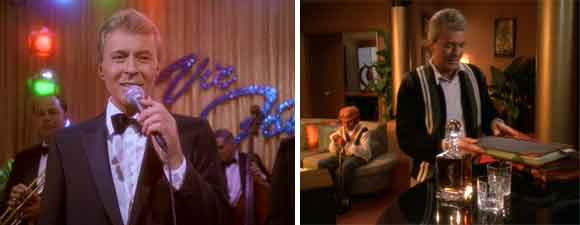Retro Review: The Abandoned
8 min readWhen a genetically engineered young boy is brought aboard the station, Odo tries to help him overcome his biological instinct to kill.
Plot Summary: While Jake watches his girlfriend Mardah work the Dabo tables, Quark is persuaded to purchase the wreckage of a ship from the Gamma Quadrant. When Quark goes to inspect his new treasure, he discovers an infant hidden in the equipment. Bashir is unable to identify the baby’s species but tells a cooing Sisko that it has incredibly fast metabolism – so fast that Bashir suspects it might be genetically engineered. Within a few hours, the baby looks and speaks like an eight-year-old. It soon becomes apparent that the child is a Jam’Hadar. Sisko promises to help the boy but is distracted getting to know his own son’s girlfriend, whom he discovers is intelligent and encouraging of Jake. Starfleet Command demands that the Jem’Hadar be turned over to them for study, but Odo protests, feeling a double responsibility since his people created the Jem’Hadar and since he himself was raised as a lab specimen – a situation from which he is still recovering, as his exploration of his newly assigned quarters reveals. The boy behaves in a worshipful manner toward Odo since he is a Founder, and Odo is at first able to help the boy control his violent impulses by working out his aggressions in a holosuite. In the ship’s wreckage, Bashir discovers a supply of a genetically engineered enzyme, apparently created to instill loyalty and dependency on the Founders, and at first it seems that the boy is willing to explore his background and options with Odo. But the impulse toward violence proves too strong, and when Sisko tells Odo that Starfleet is demanding custody of the boy, the young Jem’Hadar appears and threatens violence. Odo asks Sisko for a runabout, saying that he would rather go to the Gamma Quadrant with the boy than risk deaths on the station, but the boy does not want an ongoing association with Odo, whom he finds to be weak and compromised by his life among humans. Instead Odo takes the boy into the Gamma Quadrant to find his own people, then returns to the station, where he admits to Kira that the boy’s genetic programming as a killer was too strong for him to break.
Analysis: “The Abandoned” is another episode that I didn’t much like when it first aired – I just reread the review I wrote then – which in hindsight seems excellent in so many ways, as if the writers had a grand scheme for Deep Space Nine and all its characters all along (in fact, what’s clear is that they did an exceptional job of keeping track of small details tossed out in the early seasons to make them more and more relevant in later seasons). It struck me as derivative of The Next Generation‘s “I, Borg” – with some B-plot parental bonding a bit too reminiscent of Beverly’s “motherly advice” scenes with Wesley, while the Jem’Hadar holosuite battles looked awfully like Worf’s Klingon training adjustment programs. I suppose none of that has changed, but these moments all seem crucial for the characters and the larger storylines now, particularly for Odo upon whom most of the events of “The Abandoned” pivot. Even the title is reminiscent of “The Alternate” and “The Forsaken,” the two most obvious prequels apart from the series-changing trilogy from the end of the second season and the start of the third. Over and over, we will see Odo challenged about what it means to be a shapeshifter among humanoids, now bearing the weight of knowing exactly what sort of people created him and sent him out alone. He wants to find a kindred soul, and looks in many places – this Jem’Hadar child, a fellow changeling exile, and Kira, for whom his love is becoming ever more obvious – yet all his efforts keep leading him back to the inevitable realization that, like it or not, he is a Founder, and he can never feel complete until he accepts all the responsibility and loyalty of that bond. What seemed contrived when I first watched “The Abandoned” (whose title I assumed referred to the young Jem’Hadar) now seems heartbreaking, a look at Odo’s profound isolation on a station full of families and games and shared pleasures.
Kira’s reactions to Odo’s choices are fascinating, too. I hesitate to try to analyze her behavior in regard to Odo at a stage where I don’t think the series writers had any plans to explore their relationship in a romantic sense, but it looks in hindsight like she’s carefully defining boundaries, wanting to share Odo’s private life while at the same time protecting herself from differences that are much more than skin-deep. Where I was once angry that she seemed once again like the insensitive loudmouth from “Playing God,” insisting that they should get the young Jem’Hadar off the station as soon as possible, she now seems to me to be protecting her own – Odo in particular, but also Bashir and Sisko and everyone else in danger of becoming attached to this being that they may never be able to help or even to defend themselves against. Deep down, she rarely accepts that people can change: she always expects Dukat to behave like a megalomaniac, she waits for Winn to uncover her scheming, and now that she knows who Odo’s people are, she is likely already fearing that the Founder in him will prove stronger than the man he’s become (which, under Dominion occupation, it does seem to do). Odo counters that she was trained as a terrorist yet isn’t one any more, but it’s not quite the same thing: she fought in service of a goal, and once that goal was achieved, she put aside the violence with which she was never comfortable and accepted a role in diplomacy and compromise more easily than even she likes to acknowledge. She’s become the sort of person who goes to Starfleet dinner parties and brings flowers as a housewarming present despite an uncomfortable sense that it’s sort of silly, yet she understands that the gesture matters more than the nature of the gift. When she realizes the possibility that Odo may put responsibility to the Jem’Hadar boy ahead of his obligations on the station, she isn’t just frightened for his safety from a trained killing machine; she’s afraid of losing Odo in a more complicated sense.
There are some plot holes never filled in sequels, like whether the infant Jem’Hadar was planted to see what Starfleet would do with him and how the Dominion used what information he brought back from the Alpha Quadrant. The ending seems like a setup for a sequel that never arrives, at least not directly, for though we get to know other Jem’Hadar, this isn’t a Hugh situation where one individual’s brief contact with humans will have an impact on an alien culture. At first Sisko loves the idea of having a paternal relationship with this new arrival on the station – director Avery Brooks said that he saw the story about young men of color and how they are feared by the societies that create them – but he quickly realizes that the relationship he needs to work on is with his own son, whom he fears at first is dating a sexy older woman for the obvious reasons, only to discover that Mardah is a bright, sensitive young woman who’s had a difficult life and tried to make the best of her limited options – plus she knows Jake better than his father does, and Sisko realizes that had that not been the case, he might have given Jake more credit for his choices. There are some nice moments between Sisko and O’Brien, the only other regular who currently has children of his own, discussing parenting, though not for the first time I wish he’d also included Dax, who’s been a parent several times over. The speed with which she’s ready to hand the mystery baby over to a Bajoran orphanage – particularly since we’ve seen Bajoran orphanages, which are overburdened and bureaucratic in the wake of the Occupation, hardly a dream home for any abandoned child – is unnerving and probably ruins any chance of Odo, too, appealing to her for advice as he takes on a parental role. Then again, Dax has probably never had the experience of being worshiped as a god.
Odo has grown so much this season, moving out of his bucket to explore what it really means to be a shapeshifter, inviting Kira to share his private thoughts and fears even when he has to acknowledge that she’s right about things he’s not ready to face, like the fact that his people may have done something unforgivable not only in abandoning him but in creating the Jem’Hadar. It’s obvious during the holosuite battles that Odo is never going to succeed in turning the boy away from his violent impulses, yet we’re still rooting for him so much so that Kira’s warnings sound unduly harsh. We get our first glimpse here of the reverence in which the Jem’Hadar hold the Founders, but Odo isn’t really a Founder and this boy isn’t really a full Jem’Hadar. Can a god order a creation to have free will? The answer, it seems in this case, is no, though in a way the boy is indeed exercising free will when he refuses to allow Starfleet to take him to a starbase. How much more dangerous things could have become if Odo had decided to test his genetically programmed role and ordered the boy to obey. It might have pleased Sisko in the short term, but Sisko never suggests that Odo try, for Sisko knows better than to try to make Odo into something he‘s not. I do wonder, though, whether Sisko ever received secret orders from Starfleet to observe Odo the same way Starfleet wants to test the Jem’Hadar…not to try to dismiss him, as Odo feared a few months earlier, but to study him as representative of the Founders so that Starfleet could calculate his weaknesses. I’d like to believe that Sisko would refuse such an order, but Section 31’s final solution for the changelings demonstrates that for some, Odo never quite stops being a laboratory specimen.







The Abandoned is a great – but not completely typical – DS9 episode. It’s like Starship Down in season four – an episode needed for arc purposes (explain the threat of the Jem’Hadar & develop Odo’s ambiguous relationship with his people) with a straightforward – even derivative – plot which works because of the details that the writers drop in along the way. O’Brien’s aside to the camera – Godspeed, Jake – rings true with its knowing wisdom (& makes you regret once again that there wasn’t room to develop the Sisko/O’Brien relationship more in the show) while the Odo/Kira storyline is cautiously advanced towards the big Fascination revelation. There’s even the glorious unspoken joke that Jake’s relationship with Mardah shows how much he misses his mother….
I love it; & accept the fact that most non-Niners won’t
I’m really fascinated to read the quite positive reassessments of this episode both her and on avclub.com’s reviews (which are nearly synchronized at present). I shall have to revisit it. I remember thinking that the episode’s morality was sketchy, delivering the message that the Jem’hadar, while somewhat sympathetic because of their compulsive loyalty to the Founders, are also beyond redemption — meaning we can blow them up as much as we like a feel good about it.
That message is mostly there. It gets altered slightly as the series progresses, but largely escapes intact.
I watch this episode in the rotation, but it scores pretty low here.
I like the performance from the Jem’hadar character, and the B plot was good character building. I think Meg’s review here is reading a lot more into minor things then is there and she’s putting more thought into the episode than the writers did.
Mardah had plenty to interest a teenage boy without being a maternal figure
Maternalism wasn’t the image i had in mind….
(Neither did Jake, i’m sure)